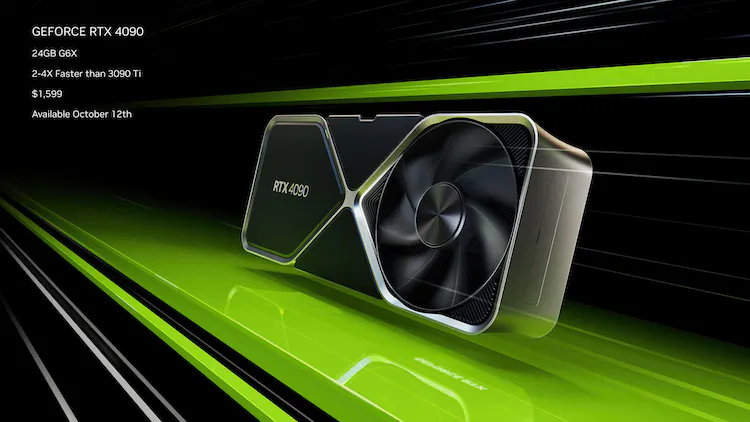Nvidia has Finally Unveiled the Next-Generation RTX 4090 and RTX 4080 GPUs
Today, Nvidia officially unveils its RTX 40-series GPUs. The RTX 4090 and RTX 4080 are officially confirmed after months of speculation and some recent tease from Nvidia. The RTX 4090 will be available on October 12th for $1,599, while the RTX 4080 will be available in November for $899. Both use Nvidia’s next-generation Ada Lovelace architecture.
Nvidia RTX 4090 GPU Specs

The RTX 4090 is the most expensive card in the Lovelace generation. It will come with a whopping 24GB of GDDR6X RAM. Nvidia claims it is 2-4x quicker than the RTX 3090 Ti while consuming the same amount of power. Based on a PC with a Ryzen 5900X processor, Nvidia advises a power supply of at least 850 watts.
The RTX 4090 has 16,384 CUDA Cores, a base rate of 2.23GHz that can be increased to 2.52GHz, 1,321 Tensor-TFLOPs, 191 RT-TFLOPs, and 83 Shader-TFLOPs.
Nvidia RTX 4080 GPU Specs
The RTX 4080 is available in two variants, one including 12GB of GDDR6X memory and a second with 16GB of GDDR6X memory, and Nvidia states it is 2-4x faster than the current RTX 3080 Ti. The 12GB variant will cost $899 and will have 7,680 CUDA Cores, a 2.31GHz base clock that can be increased to 2.61GHz, 639 Tensor-TFLOPs, 92 RT-TFLOPs, and 40 Shader-TFLOPs.
The RTX 4080 16GB variant is more than just a memory upgrade. It costs $1,199 and has 9,728 CUDA Cores, a base rate of 2.21GHz that can be increased to 2.51GHz, 780 Tensor-TFLOPs, 113 RT-TFLOPs, and 49 Shader-TFLOPs of power. The 12GB RTX 4080 will need a 700-watt power supply, while the 16GB version will demand at least 750 watts. Both RTX 4080 variants will be available in November.
All three of these RTX 40-series gpus will incorporate new Nvidia ShadowPlay technology, allowing them to capture gameplay in HDR at up to 8K resolution at 60 frames per second. Nvidia is also employing their newest Encoders (NVENC) with AV1 encoding capabilities and enhanced efficiency for AV1 livestreams.
A fresh RTX launch would be incomplete without Nvidia’s own Founders Edition gpus. Nvidia will sell its own-design GeForce RTX 4090 and RTX 4080 (16GB) graphics cards. The corporation has upgraded the design yet once again.
“For our new GeForce RTX 40 Series Founders Edition graphics cards, we’ve further optimized the Dual Axial Flow Through system, increasing fan sizes and fin volume by 10%, and upgrading to a 23-phase power supply,” adds Andrew Burnes, technical marketer at Nvidia. “Memory temperatures are reduced, and the new, substantially more powerful Ada GPUs are kept cool in ventilated cases, giving gamers excellent overclocking headroom.”
ATX 3.0 Power Supplies, PCIe Gen-5 16-pin Connectors
Instead of the special solution it designed for its own RTX 30-series Founders Edition GPUs, Nvidia is adopting the PCIe Gen-5 16-pin socket with its own RTX 40-series cards. It’s a singular cable which will power a 40-series card, similar to the previous connector, or you may use an adaptor supplied in the package to connect triple 8-pin power connectors. Nvidia suggests connecting a fourth one for “more overclocking headroom.”
ATX 3.0 power supplies with PCIe Gen-5 16-pin connectors will be available in October via Asus, Cooler Master, Gigabyte, MSI, and ThermalTake, FSP, iBuyPower. Additional models from other manufacturers are also on the way.
Third generation of RTX: Ada Lovelace
Titled after the the First Computer Programmer. It is intended to significantly improve ray tracing while also supporting Deep Learning Super Sampling (DLSS) 3.0. This new architecture would also serve as the basis for Nvidia’s next-generation consumer GPUs.
Nvidia debuted its third-generation Ada Lovelace RTX architecture today with a Racer X demo, which simulates an off-road kart racing game. The Racer X demo was driven by a single Ada Lovelace GPU with 76 billion transistors and manufactured on TSMC’s 4nm technology.
Ada Lovelace also incorporates third-generation RT cores, which are intended to increase ray tracing significantly. A new DLSS 3.0 AI that analyzes the new frame and the previous frame to determine how game scenes are moving contributes to some of the improvements. DLSS 3.0 enabled Nvidia to more than double Microsoft Flight Simulator frame rates.
The release of the RTX 40-series cards comes at a difficult time for Nvidia as well as the GPU market as a whole. The crypto crisis impacted GPU demand, and more lately, the dominance of GPU-based crypto mining has decreased as a result of Ethereum’s switch to proof of stake. Nvidia’s gaming revenue fell by a whopping $1 billion during its most recent earnings report.
The focus of Nvidia’s launch is on its first party “Founders Edition” graphics cards, but they will be marketed alongside GPUs from hardware vendors such as Asus, Colorful, Gainward, Galaxy, Gigabyte, INNO3D, MSI, Palit, PNY, and Zotac. These third-party GPU variants use the same Nvidia chipsets as the originals, however they may be setup differently and feature different coolers. However, don’t expect to see RTX 40-series GPUs from EVGA, which recently revealed that it will no longer manufacture Nvidia graphics cards due to the chipmaker’s terrible behavior.
Despite the fact that its successor is officially announced, earlier RTX 30-series GPUs are expected to be accessible for some time. Nvidia confessed earlier this year that it developed quite many GPUs and then was forced to modify retail pricing owing to surplus inventories. This led in RTX 30-series cards becoming available at MSRP after years of price increases by resellers, which was a visual delight for cash-strapped PC users.
Nvidia will now launch its RTX 4090 graphics card first, on October 12th, followed by the two RTX 4080 units later in November.
We’ll be covering all Nvidia announcements live during the event, so stay tuned for the most up-to-date information on Nvidia’s next-generation GPUs.
Like us on Facebook and Follow us on Twitter for latest updates.
For latest news in your hands Follow us on Google News.